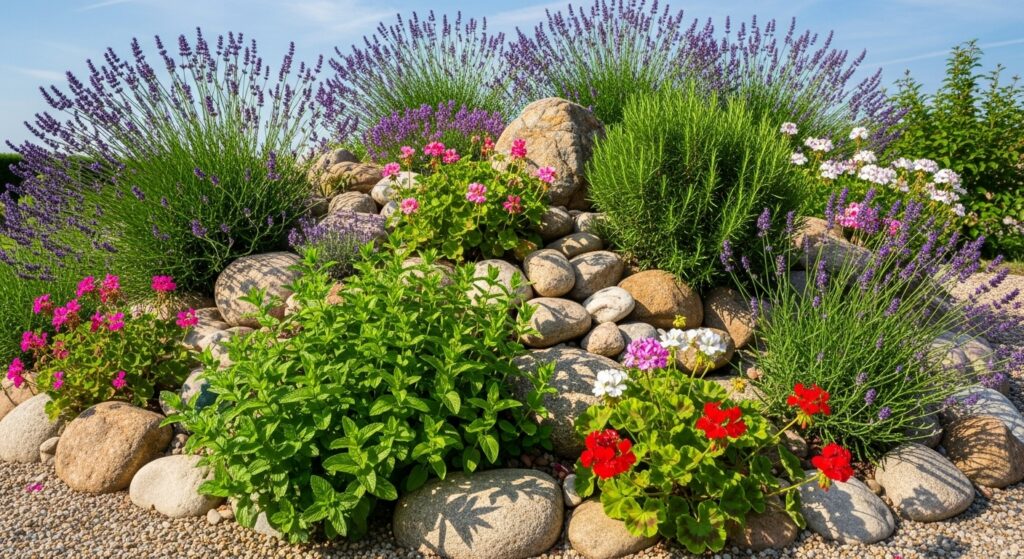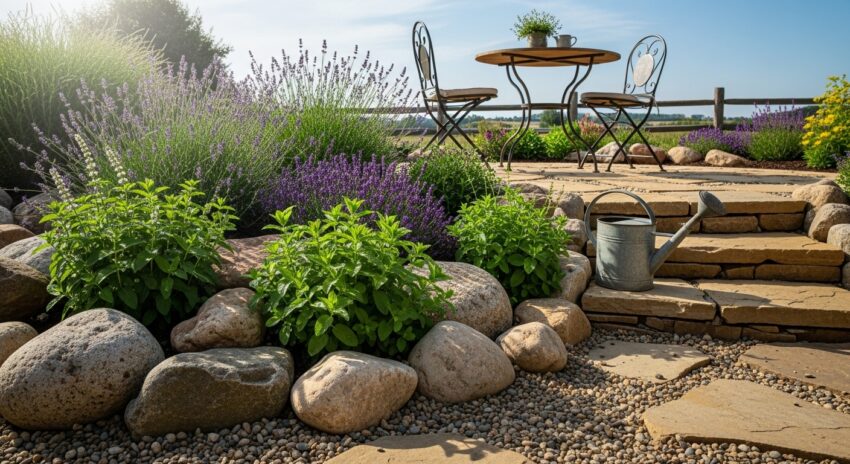Natural Bug-Repellent Plants and Essential Oils for a Healthier, Chemical-Free Summer

If you’ve ever wanted to keep mosquitoes, ticks, blackflies, or ants away without using harsh chemical sprays, nature already provides the perfect solution. Many common herbs and plants contain the same essential oils that are used to create natural bug repellents. By learning which plants repel which insects, you can craft a customized natural repellent that suits your specific needs — whether it’s a garden barrier, a spray, or even a bug-repelling rock garden.
Why Natural Bug Repellent Plants Work
Plants naturally produce aromatic compounds to protect themselves from pests. Those same compounds — found in essential oils like citronella, lemongrass, lavender, and peppermint — are what help us keep bugs at bay too. When you crush or distill these plants, you release their natural oils, creating an effective (and beautifully scented) bug deterrent that can be used in sprays, soaps, or outdoor planters.
Creating a Natural Bug-Repelling Garden
A bug-repelling rock garden can be both functional and attractive. Mix fragrant herbs like lavender, mint, basil, and citronella grass among rocks and stepping stones near patios or doorways. These plants give off protective aromas every time the sun warms their leaves or the wind brushes past them.
You can also place potted versions of these herbs around outdoor seating areas or near open windows for a steady, natural barrier against flying pests.
The Power (and Caution) of Neem Oil

One of the strongest natural bug repellents is Neem oil, pressed from the seeds of the Neem tree. Its scent is notoriously strong — some would say downright unpleasant — but it’s incredibly effective. Neem oil has been used for centuries in India and other parts of Asia not only as a bug repellent but also for treating skin conditions.
If you plan to use Neem oil in a spray, warm it gently before mixing so it liquefies, then combine it with distilled water or witch hazel in a spray bottle. Always wear gloves and a mask while handling concentrated Neem oil — the aroma alone can make even the strongest stomach turn.
Despite its scent, Neem oil has remarkable benefits for the skin, including antibacterial and antifungal properties, making it a valuable addition to natural skincare and outdoor protection blends.
Best Natural Bug-Repelling Plants and Oils
Below is a helpful guide to plants and essential oils that repel specific types of insects.
For Ticks
-
Lavender
-
Cedar or Cedarwood (Texas)
-
Rosemary
-
Lemongrass
-
Peppermint
-
Geranium
-
Eucalyptus
-
Pennyroyal (effective but toxic — use with extreme caution)
-
Cedar branches (great in campfires or bundles)
💡 Tip: Mix cedarwood, lavender, and geranium essential oils in a carrier oil (like grapeseed or coconut) for a natural tick-repelling skin blend.
For Mosquitoes
-
Citronella (5–10% of your mixture)
-
Neem oil (1–2% of your mixture)
-
Tea tree
-
Peppermint
-
Basil
-
Lemon-eucalyptus (one of the main ingredients in many DEET alternatives)
-
Pennyroyal (toxic if ingested — not recommended around children or pets)
-
Thyme
-
Lavender
💡 Tip: Combine lavender, basil, and lemon-eucalyptus essential oils in witch hazel and distilled water to make an easy backyard mosquito spray.
For Blackflies
-
Lavender
-
Eucalyptus
-
Tansy
-
Cedar
-
Citronella
-
Peppermint
-
Lemongrass
💡 Tip: A few drops of peppermint or citronella oil on a cotton ball tucked into your hat or shirt collar can help keep blackflies away while you garden.
For Ants
-
Peppermint
-
Spearmint
-
Lime
💡 Tip: Create a natural ant-repelling spritzer with fresh mint and lime essential oils mixed in water and spray it around windowsills or door frames.
A Note About Pennyroyal Essential Oil
Pennyroyal has long been recognized as an effective insect deterrent, but it comes with serious warnings. It’s toxic if ingested or absorbed in large amounts through the skin. When I first opened my soap store, we made a conscious decision not to carry any oils considered toxic, especially since children and staff were often in the workspace.
If you’re making a repellent for casual home or garden use, it’s best to skip Pennyroyal entirely. Safer options like peppermint, lavender, and citronella will give you excellent results without the risks.
Homemade Bug-Repellent Soap and Sprays
You can also enjoy lasting protection by using bug-repellent soap made from natural oils. My Entomophobia Bug-Repellent Soap Recipe combines some of these same plant oils into a gentle, effective bar that’s perfect for summer outdoor use.
For sprays, blend essential oils like citronella, lavender, and lemon-eucalyptus with distilled water and witch hazel in a glass spray bottle. Shake well before each use and store it in a cool place away from direct sunlight.
Final Thoughts
By growing or blending natural bug-repelling plants, you can protect yourself and your family from pests — safely and naturally. Whether you make a rock garden, soap, or homemade spray, these plant-based solutions are not only healthier but also beautifully aromatic.
Nature has always had the answer — we just need to grow it, blend it, and enjoy it.
© 2024 – 2025, Tes. All rights reserved.

While researching natural remedies, and surfing the internet i came across your website and I must say, I’m impressed by the wealth of information available here! The articles are incredibly insightful and well-written, offering valuable tips and recipes for crafting natural soaps and skincare products. I particularly enjoyed exploring the section on bug repellent plants, as I’m always on the lookout for eco-friendly ways to keep pesky insects at bay. However, I’m curious about the effectiveness of certain plants mentioned, like citronella and lavender, in repelling bugs. Can anyone share their experiences with using these plants for insect control? Additionally, are there any other lesser-known bug repellent plants worth considering? I’d love to hear some personal insights from fellow nature enthusiasts. Thank you
Thank you so much for your kind words! I’m really glad you enjoyed the article and found it helpful. 😊
Citronella and lavender are both quite effective, especially when used correctly. Citronella works best when the plant or oil is crushed or diffused—it masks scents that attract mosquitoes. Lavender, on the other hand, has a gentler scent that many people love but most insects don’t! It’s especially good at deterring moths and mosquitoes.
For lesser-known options, you might also try lemongrass, geranium, and rosemary—all of which naturally repel certain insects. Neem is another powerhouse (though quite strong-smelling!) that’s great for both skin care and bug protection.
I’d love to hear how others have used these plants too—everyone’s experiences can vary depending on region and growing conditions!
Thanks again for visiting and sharing your thoughts. 🌿